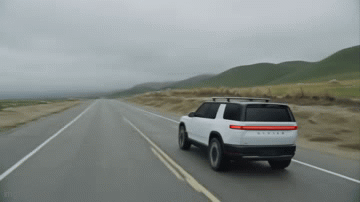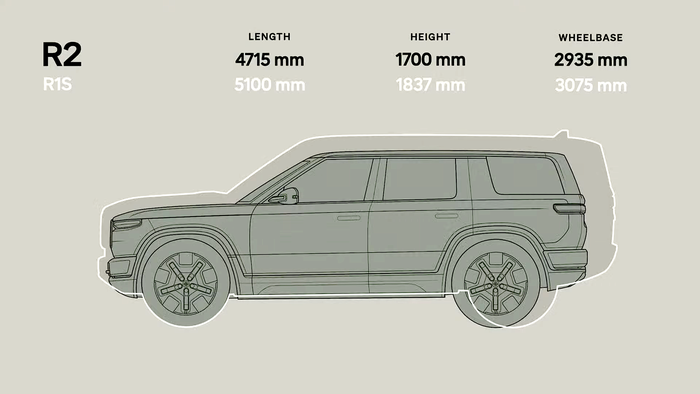Rivian Reveals Some Tech Details of its $45,000 Compact Models
Rivian is aiming for the heart of the high-volume market with a pair of new compact crossover EVs.

2026 Rivian R2 SUVRivian
At a Glance
- R2 starts at $45,000
- R3 will be less expensive than R2
- Both models will have 300+ mile capability
Rivian introduced its new R2 and R3 models (plus an R3X performance variant) to demonstrate the company’s ambitious plans for the future. These new vehicles are built on what company founder and CEO RJ Scaringe describes as an “all-new platform,” though obviously it leans heavily on designs and know-how from the existing R1 models.
The company provided scant technical information at the announcement of the new models, which will not arrive until 2026, but Scaringe did elaborate a bit in a post-event discussion with Sandy Munro’s Munro Live.
“We are seeing, for us as a company, a big wave of innovation, because that’s just such a focus point given all the pains we’ve gone through in ramping R1, to simplify designs, consolidate parts, eliminate parts that are not necessary,” he told Munro. “That manifests really fully in R2 where we had the benefit of [it] being a clean sheet.”
“With R1 we continue to make progress and improvements, but it is off of an existing platform, whereas R2, we said ‘We’re going to make a smaller platform, it needs to hit this price, to do that, the bill of materials needs to look like this,’ Scaringe explained. “It must, if you’re going to hit that price, and it led to great innovations around some of the work that we’re doing.”
Some of the changes include the use of large-scale high-pressure die castings in the chassis, the use of a structural battery that doubles as the cars’ floor, and closure systems for the doors that Rivian says dramatically reduce complexity.
Meet R2 and R3
The R2 is a two-row compact crossover SUV that looks very much like a scaled-down R1, which should please fans of the R1 who want something just a bit smaller and less expensive. It stretches 185.6 inches, making it 15 inches shorter than the R1. The R2 also stands 5.3 inches lower at the top of the roof and it rolls on a wheelbase of 115.55 inches which is 5.0 inches shorter than that of the R1. This vehicle’s price will start at $45,000 and it is scheduled to arrive in the first half of 2026.
The R3 is an even smaller hatchback, along the lines of Hyundai’s Ioniq 5. Like that car, its silhouette is reminiscent of the classic Mark I Volkswagen Golf, though one that is probably 25 percent larger. Rivian provided even less detail on the R3, only saying that its wheelbase is another five inches shorter than the R2’s, so the step change in size between the models is similar. No pricing was announced for the R3, other than that it will be lower than the R2’s $45,000 starting price.
Enduro Motors
Both the R2 and R3 are powered by upcoming iterations of Rivian’s in-house Enduro drive units that are employed on the Rivian Commercial Van and are available on the R1 at a lower price than the original Bosch-supplied motor versions of that vehicle. Both the R2 and the R3 will be available with one, two, or three of the Enduro motors, providing the performance level and price to match customers’ preferences.
The single-motor model is rear-drive, while the dual-motor positions an electric drivetrain at each end of the vehicle for all-wheel-drive. The tri-motor version adds another motor to the rear axle, providing 0-60 mph acceleration of less than 3.0 seconds.
New Batteries
There will be two available battery pack sizes, and again, Rivian provided no detail on the capacity of either pack. They do say, however, that the larger pack will provide more than 300 miles of driving range.
These new packs employ larger-diameter 46-mm wide 4690 cells in place of the skinny 21 mm cells used in current Rivian models. “We wanted to fit the biggest cell that we could into the floor [space] that we have, so 4695 is a nice balance,” said Scaringe. “Also, thermally, as you start to get any taller than [90 mm] you start to run into these thermal gradating issues across the height of the cell. The 4695 is a really nice balance and [is] super cost-efficient.”

The R2's silhouette compared to that of the R1. RIVIAN
Charging Plans
The R2 and R3 will both be equipped with Tesla’s North American Charging System charge ports and will offer the ability to charge at 350 kilowatts from a 20 percent level to an 80 percent state of charge in half an hour. In line with Tesla practice, the charge ports will be on the side of the vehicle toward the rear.
Additionally, Scaringe said in his Munro Live conversation that both models will support bidirectional charging using Level 2 AC home chargers that will provide home backup power. He also revealed that the company is exploring plans for bidirectional home DC fast chargers.
“We also think there’s the opportunity for bidirectional DC charging, which requires an in-house bidirectional DC charger, so that’s more equipment in the house, but that would allow you to charge even faster,” he said. “But, at a baseline, we think having bidirectional AC is really important. That will be included in the R2.”
Rivian is also planning an advanced driver assistance system to let the R2 and R3 take over steering for the driver. The company promises “dramatically enhanced autonomous capabilities” using eleven cameras and five radars to watch the car’s surroundings.
Zonal Architecture
They’ve also reconfigured the electronic system to simplify it and reduce the number of processors using a zonal architecture. “Where we’re seeing really big savings…is some of the ECU consolidation,” Scaringe said. “Because we control the design of all the computers in the vehicle, we’ve been able to move to a much smaller number of computers.”
“We have a front-left, a front-right, a rear-left, a rear-right that do all the functions,” he continued. “It’s not domain-based or function-based but rather zonal. That allows us to take thousands of dollars of cost out relative to what you’d see with a more traditional architecture.”
Window Example
Scaringe also talked about Rivian’s philosophy of simplification in developing R2 and R3. “I’ll give you a good example that is maybe not immediately visible; the rear door on the R1S has a full drop glass,” he said. “But to accomplish that, we have a fixed-glass portion with a [divider] bar.”
The R2’s design eliminates those additional parts. “On R2, we sized the vehicle and the wheelbase and the closures such that we have a full drop glass, but there’s no fixed glass or [divider] bar,” Scaringe explained. “It looks really cool, but it also gets rid of the [divider] bar, the corner muckets around that, all the sealing around that, so it takes a lot of parts and complexity out.”
The result is even better looking while it also saves cost and reduces assembly complexity. “It looks really clean and simple,” he continued. “So, I’d say it is actually a customer benefit, but it required a lot of iteration. A lot of work to get to a simpler door. Those are the kinds of things we’re driving into R2, to get to the $45,000 price point.”
About the Author(s)
You May Also Like





